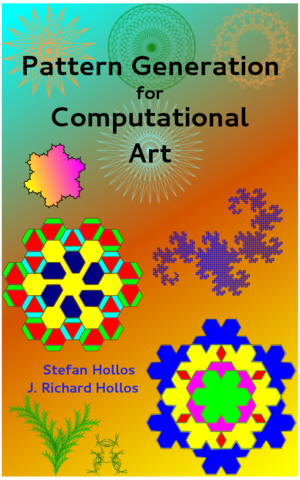Pattern Generation for Computational Art
Stefan Hollos and J. Richard Hollos
Format and pricing: Paperback (375 pages) $21.95, Kindle/pdf $9.95
ISBN: 9781887187183 (paperback), 9781887187190 (ebook)
Publication date: December 2013
 |
 |
This book shows how to turn computer generated number sequences into intricate visual patterns. The sequences are strings of the binary numbers 0 and 1 which are translated into drawing instructions to produce beautiful patterns. These patterns provide a glimpse of the hidden platonic world of mathematics.
The book starts with Christoffel words and Sturmian sequences which are derived from the continued fraction expansion of rational and irrational numbers. How this is done is explained very clearly in the book and very little mathematical background is required from the reader.
The book moves on to Automatic sequences such as the Thue-Morse and Rudin-Shapiro sequences which are various ways of calculating digital roots of the integers. The first part of the book ends with sequences generated by folding paper.
Translating a sequence into drawing instructions is done using a finite automaton. This is a very general method for translating sequences that allows the same sequence to produce many different patterns. No prior experience with finite automata is necessary. All the background needed is explained in the book.
The second part of the book is devoted to L-systems which is another way of producing a string of drawing instructions. Here the strings are produced by an iterative symbol substitution process. The images produced often have a self similar fractal structure. It is possible to create many images that resemble plants. The book shows how to use an automaton and context free grammars to systematically look at all L-systems of a particular type.
All software used to create the sequences and images in the book are free for readers to download here.
The software consists of small programs written in the C programming language that can be run on all major operating systems. Inside the book are 327 images serving as inspiration for what you can create. There are an infinite variety of images you can generate using the software that comes with this book, providing a computational image generation lab.
These videos show some of the patterns you can create.
A Gallery of Images from the book.
About the authors
Stefan Hollos and J. Richard Hollos are physicists and electrical engineers by training, and enjoy anything related to math, physics, engineering and computing. They are brothers and business partners at Exstrom Laboratories LLC in Longmont, Colorado.
Table of Contents
- Preface
- Introduction
- Words, Sequences and Folding
- Christoffel Words
- Drawing Translation
- Producing a Drawing
- Continued Fractions
- Square Root of 3
- Square Root of 5
- Square Root of 17
- Golden Ratio
- Transcendental Numbers
- Automatic Sequences
- Paper Folding
- Lindenmayer Systems
- Formal Definition
- Graphical Interpretation
- Koch Curves
- Edge Rewriting
- Generating Images
- Introducing Autogen
- Coupled Production Rules
- Branching
- Appendix A: katrans Automaton Files
- Appendix B: Continued Fractions
- Appendix C: Programs
- Further Reading
- Acknowledgements
- About the Authors
Send comments to: Richard Hollos (richard[AT]exstrom DOT com)
Copyright 2022 by Exstrom Laboratories LLC
